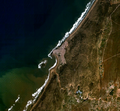Geography of Morocco
This article provides insufficient context for those unfamiliar with the subject. |



Morocco is a Northern African country, bordering the North Atlantic Ocean and the Mediterranean Sea, between Algeria and the annexed Western Sahara.
A large part of Morocco is mountainous. The Atlas Mountains are located mainly in the center and the south of the country. The Rif Mountains are located in the North of the country. Both mountains are mainly inhabited by the Berber people.
Geographic coordinates: 32°00′N 5°00′W / 32.000°N 5.000°W
Map references: Africa
Area (excluding the annexed Western Sahara):
total:
446 550 km²
land:
446 300 km²
water:
250 km²
Area - comparative: slightly larger than California
Land boundaries:
total:
2 017.9 km
border countries:
Algeria 1 559 km, Western Sahara 443 km, Spain (Ceuta) 6.3 km, Spain (Melilla) 9.6 km
Coastline: 1 835 km
Maritime claims:
contiguous zone:
24 nautical miles (44 km)
continental shelf:
200-m depth or to the depth of exploitation
exclusive economic zone:
200 nautical miles (370 km)
territorial sea:
12 nautical miles (22 km)
Climate: Mediterranean, becoming more extreme in the interior
Terrain: northern coast and interior are mountainous with large areas of bordering plateaus, intermontane valleys, and rich coastal plains
Elevation extremes:
lowest point:
Sebkha Tah -55 m
highest point:
Jbel Toubkal 4 165 m
Natural resources: phosphates, iron ore, manganese, lead, zinc, fish, salt
Land use:
arable land:
21%
permanent crops:
1%
permanent pastures:
47%
forests and woodland:
20%
other:
11% (1993 est.)
Irrigated land: 12,580 km² (1993 est.)
Natural hazards: northern mountains geologically unstable and subject to earthquakes; periodic droughts
Environment - current issues: land degradation/desertification (soil erosion resulting from farming of marginal areas, overgrazing, destruction of vegetation); water supplies contaminated by raw sewage; siltation of reservoirs; oil pollution of coastal waters
Environment - international agreements:
party to:
Biodiversity, Climate Change, Desertification, Endangered Species, Hazardous Wastes, Marine Dumping, Nuclear Test Ban, Ozone Layer Protection, Ship Pollution (MARPOL 73/78), Wetlands
signed, but not ratified:
Environmental Modification, Law of the Sea
Geography - note: strategic location along Strait of Gibraltar
References
External links
- European Digital Archive on the Soil Maps of the world Soil Maps of Morocco











